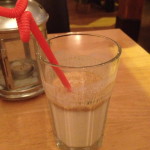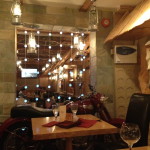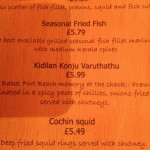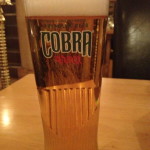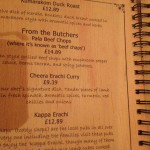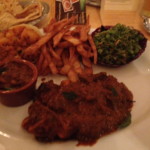The moment I saw Kayal I knew I had to try it, if only because it makes such a concerted attempt to be different and to appeal based on solid virtues like unusual but freshly-cooked dishes. In view of my comments about chains, Kayal makes for an interesting contrast.
This is a small chain of restaurants based in the Midlands, serving authentic food originating from Kerala in the south of India. It also offers franchising opportunities and seems to be run by owners with a keen eye for marketing opportunities (eg. They are very social networking-aware, with Facebook pages and a Twitter account.) In reference to other restaurant chains I’ve said clearly that this is being achieved at the expense of optimising the quality of food served, so an alternative view is very welcome in what appears an extremely popular restaurant among the many on Regent Street in the genteel Midlands town of Leamington Spa.
Being South Indian is in itself unusual, given that most “Indian” restaurants are actually Bangladeshi or Pakastani in origin, serving food based on the Mughal tradition of tandoor-cooked meat and thick curried sauces. Kerala, by contrast, has a range of different influences and ingredients (courtesy of Wikipedia):
Ingredients
Coconuts grow in abundance in Kerala, and consequently, coconut kernel, (sliced or grated) coconut cream and coconut milk are widely used in dishes for thickening and flavoring. Kerala’s long coastline, numerous rivers and backwater networks, and strong fishing industry have contributed to many sea and river food based dishes. Rice and cassava (Tapioca) form the staple food of Kerala. All main dishes are made with them and served along with Kootan; the side dishes which may be made from vegetables, meat, fish or a mix of all of them. The main dish for lunch and dinner is boiled rice. The Kerala breakfast shows a rich variety; the main dishes for which are made from rice flour, or fresh or dried cassava. Owing to the weather and the availability of spices, the Kerala cuisine is richly spicy especially the hot ones –chili, black pepper, cardamom, cloves, ginger, and cinnamon.
Historical and cultural influences
For over 2000 years, Kerala has been visited by ocean-goers, including traders from Greece, Rome, the eastern Mediterranean, Arab countries, and Europe (see History of Kerala). Thus, Kerala cuisine is a blend of indigenous dishes and foreign dishes adapted to Kerala tastes.
Pre-independence Kerala was basically split into the princely states of Travancore & Kochi in the south, and Malabar district in the north; the erstwhile split is reflected in the recipes and cooking style of each area. Both Travancore and northern Malabar cuisine consists of a variety of vegetarian dishes using many vegetables and fruits that are not commonly used in curries elsewhere in India including plantains (vazha-ppazham or ethaykka), bitter gourd (‘pavaykka’ in Travancore and ‘kyppakka’ in northern Malabar), Yam (‘chena’), Colocasia (‘chembu’), Ash gourd (Kumbalanga), etc. However, their style of preparation and names of the prepares dishes may vary. Northern Malabar has an array of vegetarian and non-vegetarian dishes such as pathiri (a sort of rice-based pancake, at times paired with a meat curry),porotta (a layered flatbread, said to come from South-East Asia), and the Kerala variant of the popular biriyani, probably from Arab lands. Travancore region boasts of a parade of dishes like appam that is largely identified with the Saint Thomas Christians (also known as Syrian Christians or Nasrani) of the region.
In addition to historical diversity, the cultural influences, particularly the large percentages of Muslims and Syrian Christians have also contributed unique dishes and styles to Kerala cuisine, especially non-vegetarian dishes. The meat eating habit of the people have been historically limited by religious taboos. Brahmins eschew non vegetarian items. However, most of modern day Hindus do not observe any dietary taboos, except a few of those belonging to upper caste.[1] Muslims do not eat pork and other items forbidden by Islamic law.
Historically, Kerala was part of the Tamil-speaking area, and Tamilian influence is seen in the popularity of sambar, idli and dosa. European influence is reflected in the numerous bakeries selling cakes, cream horns, and Western-style yeast-leavened bread, and in Anglo-Indian cuisine. The import of potatoes, tomatoes, and chili peppers from the Americas led to their enthusiastic use in Kerala, although except for the ubiquitous peppers, the other ingredients are used more sparingly.
Spices in Kerala Cuisine
As with almost all Indian food, spices play an important part in Kerala cuisine. The main spices used are cinnamon, cardamom, ginger, green and red peppers, cloves, garlic, cumin seeds, coriander, turmeric, and so on. Few fresh herbs are used, unlike in European cuisine, and mainly consist of the commonly used curry leaf, and the occasional use of fresh coriander and mint. While Tamarind and lime are used to make sauces sour in North Malabar areas; the Travancore region uses only kodampuli (Garcinia cambogia), as sour sauces are very popular in Kerala. Sweet and sour dishes are however, rare, but exceptions like the ripe mango version of the pulissery and tamarind-jaggery-ginger chutney known as puliinji or injipuliwhich is also known as Sou Ginger are popular.
Kayal milks the Keralan influence with its crafted appearance (though quite what stuffed pheasants were doing there I’m not quite sure), including fishermen’s baskets and lamps, and a simulated waterfall. The aim is to be atmospheric, though it may appear twee to onlookers. Initial signs are very positive in that at a relatively early time on a Tuesday evening (my cheap cinema viewing night), Kayal was humming and clearly heavily booked. Not just booked, but a good proportion of the diners were people from Indian subcontinent origins, which is to be welcomed in the same way that Chinese people eating in a Chinese restaurant will attract a keen passing trade.
The second point of note is that Kayal classes itself above the average curry house, with some prices heading steeply northwards, for which you can be right to expect good quality home-cooked food from fine ingredients, and indeed measure the restaurant against a different scale of competitors. For this reason I ordered a selection of dishes, including the top price main course – the flag-bearer of Kayal standards. However, you can eat pretty cheaply, as did the couple on a neighbouring table who ordered a sizeable single dosa (stuffed pancake) between them for less than seven of your pounds.
I began with an order for salt lassi, which afficianados will recognise as a churned yogurt drink that can be bought in supermarkets these days but which is far better made fresh to order. This lassi was not only churned freshly but was topped with an interesting spice mix including, if I read it correctly, nutmeg and/or mace. Refreshing but also more complex than your average lassi.
The starter appeared minimal, which is probably just as well in view of the main course to follow. Good quality prawns were peeled up to the tail, coated in a spicy paste, char-grilled and served on a dainty plate with tiny tubs of coconut-based chutneys and a minimal salad. What else the chutneys contained I can’t tell you, but they and the dish was exquisite. The prawns had the taste and texture of real prawns, and were complemented to perfection by the accompaniments.
The main course was my big mistake in that I succumbed to the age-old trick in an Indian restaurant by over-ordering. The beef chops and assorted side dishes were a meal in themselves, and did not need the aromatic spiced coconut rice that I ordered. Nor necessarily the beautifully crisp yet melting paratha, but that was a divine choice nobody could regret – “bread of heaven” as Welsh rugby fans might sing!
The beef chops dish was arranged with fine slices of rib meat in a fiery pepper and mushroom sauce directly in front of me (washed down by a pint of Cobra.) Around them was arranged delightful dishes of beans, unadvertised crisp plaintain chips, a potato curry and another spicy sauce served in a pot. The spicing indicated clearly these dishes were made in the Kayal’s own kitchen and were very moreish – even though I was very full by the time I had waded through two thirds of the food in front of me.
No room then for desserts, but with the charming and low-key service provided by a young waiter called Robin, I left Kayal feeling deeply satisfied and convinced that this is a place worthy of subsequent visits. It stands out from your average Indian in terms of both variety and quality, and how often can you say that? I shall undoubtedly go again, and no better praise can you give any restaurant.



